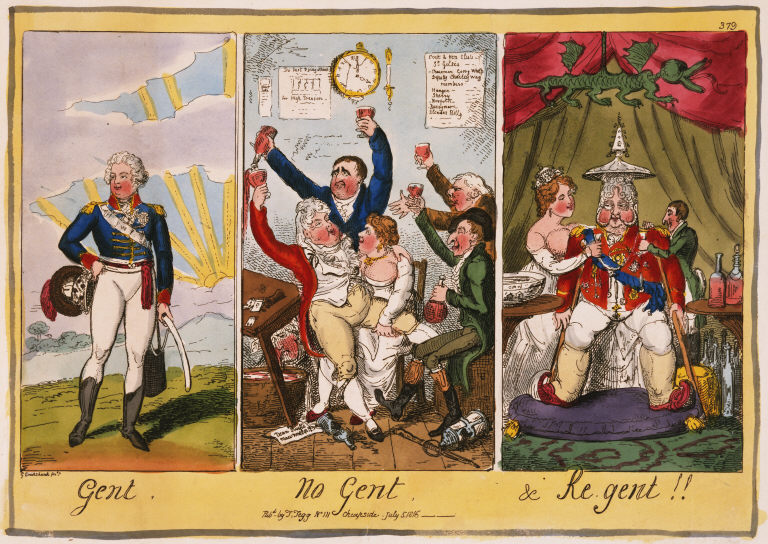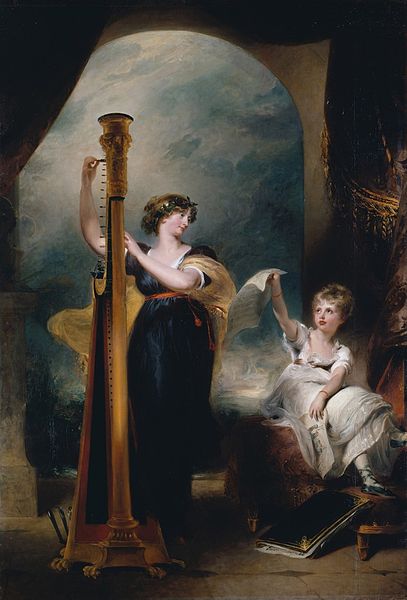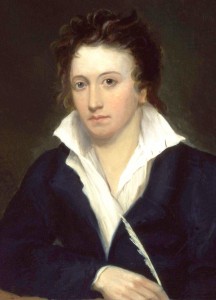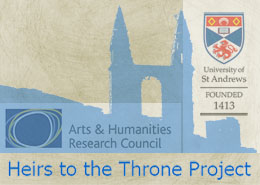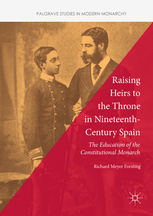‘The Last and Best of her Race’: The Varied Reaction on the Death of Princess Charlotte of Wales
Jennifer Henderson Crane
With the recent birth of the daughter of the Duke and Duchess of Cambridge in May 2015, Britain can once again boast a Princess Charlotte. Charlotte Elizabeth Diana’s full name immediately conjures two very special namesakes: the Queen, Elizabeth II, and the child’s late paternal grandmother, Diana, Princess of Wales. However, there is a third namesake, one that may be missed by many of today’s generation. The name, Charlotte, widely popular amongst current children, has not garnered much royal usage in the past two centuries, aside from a smattering of nineteenth-century princesses bearing it as one of many middle names. The last time it was bestowed on a British princess as a first name, aside from the short-lived daughter of the Duke and Duchess of Clarence in 1819, was in 1796 when Princess Charlotte Augusta was born to George, the Prince of Wales, and his wife, Princess Caroline of Brunswick. Princess Charlotte’s death at the age of twenty-one after she had endured more than two days of labour caused an outpouring of grief from all over Britain and prompted many other European royals to don mourning for the lost English Princess. Donations from the public flooded in to contribute toward a suitable monument to the queen they would never crown, and many shops soon found themselves out of mourning attire. While many grieved over her death and that of her stillborn son, Princess Charlotte’s demise also inspired a different reaction, and thus it pointed to the inconsistencies granted to one born to a life of recognition in contrast to so many others. This essay will focus upon the aftermath of Charlotte’s death, providing a glimpse of the variations of how Britain mourned a lost heir.
Since the sorrowful events that began on 5 November, when the stillborn prince was delivered, and his mother’s passing the following day, the princess’s very name has evoked one word: tragic. She had been the hope for Britain: despite her grandparents, George III and Queen Charlotte, having thirteen children (another two, both sons, died in early childhood), Charlotte emerged as the sole legitimate heir amongst numerous other grandchildren sired in adulterous affairs. Her father, with his spendthrift behaviour and penchant for womanising, was already unpopular with the public and many of his brothers were viewed in the same light. The Prince of Wales’s girth and reputation for gluttony eventually prompted his critics to dub him the “Prince of Whales,” and he provided nearly constant fodder for political cartoonists.
Sadly, the marriage that had produced Charlotte was doomed from the very start. Prince George was said to have been so shocked and disappointed by the first sight of his bride at their 8 April 1795 wedding at St James’s Palace that he immediately called for a brandy to brace him for the inevitable events to follow. Their only child, Charlotte, was very likely the product of their wedding night as she was born nine months later, almost to the day, on 7 January 1796 at Carlton House, the Prince of Wales’s principal London home.
Marriage and the creation of a child did not add any warmth to the relationship between George and Caroline. The Prince of Wales detested his wife for her coarse behaviour and inattention to personal hygiene, as well as for her flouting of the societal niceties that were de rigueur at the English court; years later he attempted to divorce her, but the proceedings ultimately failed. Their tiffs were no great secret, and even found their way into family folklore. In her autobiography, My Memories of Six Reigns, Princess Marie Louise, a granddaughter of Queen Victoria born in 1872, recounted a stay spent at Cranbourne Tower, near Windsor Castle, where, she related, “Queen Caroline was interned with Princess Charlotte during one of the unfortunate quarrels between this rather tempestuous lady and George IV.” Princess Charlotte’s betrothal and eventual marriage to Prince Leopold of Saxe-Coburg on 2 May 1816 held the promise of a brighter future, but one that never came to fruition.
Following her death, more tragedy was to come. Her obstetrician, the acclaimed accoucheur to the aristocracy Sir Richard Croft, found himself at the centre of an investigation. He had gained notoriety whilst attending on Georgiana, the Duchess of Devonshire, when she gave birth to her third child in May 1790; his fame ultimately led to his appointment to care for Princess Charlotte during her pregnancy. One of the fiercest criticisms of Croft was his failure to make use of the various available instruments, such as forceps, to help the princess during her labour. There were also suggestions that he had been asleep during her travail. His was a precarious position: his patient was the heir to the throne, the child she was to bring into the world was also an eventual heir. As handy as these instruments were, there was always a risk of danger: misuse could cause irrevocable damage, possibly endangering future childbearing—disastrous for a future queen regnant. Post-mortems on both Charlotte and her stillborn son exonerated the doctor from any wrong-doing, but the tragedy had already done its work on Croft. Three months later, whilst caring for another patient in labour in February 1818, Sir Richard Croft committed suicide. Sometime before, he had written to Baron Stockmar, a friend of Prince Leopold and one who would factor heavily in the life of his niece, Queen Victoria, that, “My mind is in a pitiable state.” What happened in the wake of Princess Charlotte’s death was too much for him to bear.
For many in the country, the demise of the princess brought much grief. Henry Brougham, a legal adviser to Princess Caroline, wrote with a sentiment echoing that felt by countless others: “It really was as though every household throughout Great Britain had lost a favourite child.” For one, the loss was the most profound: Prince Leopold, a widower who had been married for less than two years and was now a father to a stillborn son. In a letter to Sir Thomas Lawrence, a prolific painter, who had a close association with the royal family and was often commissioned to portray them, including Charlotte, Leopold wrote: “Two generations gone. Gone in a moment! … My Charlotte is gone from the country—it has lost her.” His despair did not go unmarked by others. Thea Holme, in her work Prinny’s Daughter, noted that Baron Stockmar saw that November as the ruin of Leopold, writing that, “without Charlotte he was incomplete. It was as if he had lost his heart.” He buried his wife and child on 19 November 1817 in St George’s Chapel near Windsor Castle; the fact that she, if events had turned out differently, could have sat upon the throne in the same castle so near her tomb was a painful twist of fate.

The Betrothal of Princess Charlotte of Wales and Prince Leopold of Saxe-Coburg-Saalfeld, by George Clint, c.1816
A glorious monument, paid for by public subscriptions, was created by the sculptor Matthew C. Wyatt (1777-1862); he had also been behind statues of the Duke of Wellington and Lord Nelson. Crafted in white marble, Charlotte rests at the bottom, draped with a shroud, only the fingers of one hand visible. Cloaked mourners, kneeling in grief, surround her. Above, the Princess is seen ascending to Heaven, flanked by angels, one carrying her infant son. The classical design, with an almost Grecian aspect to Charlotte’s robe, empathises the reverence felt for her. There was some consternation, though, on the memorial’s placement as it was installed inside St George’s Chapel rather than in a more public location. According to C. Andrews in his 1828 book, Visitants Guide to Windsor Castle and its Vicinity, in the spring of 1826, after it was unveiled, the public were invited to see “the majestic edifice.” While Wyatt’s creation was undoubtedly seen as fitting, there were those who felt the money was misspent. In a piece written by archival personnel of St George’s Chapel, it is recorded that London newspapers received numerous letters decrying the amount lavished on the monument, as more fitting tributes could have been paid in honour of Charlotte. Another citizen, in writing to The Times in February 1818, held a more pragmatic view of the monument. If money was to be spent on such a memorial, it should celebrate all her personal goodness and that, above all, it should “not be the mere mausoleum of her exalted rank.”
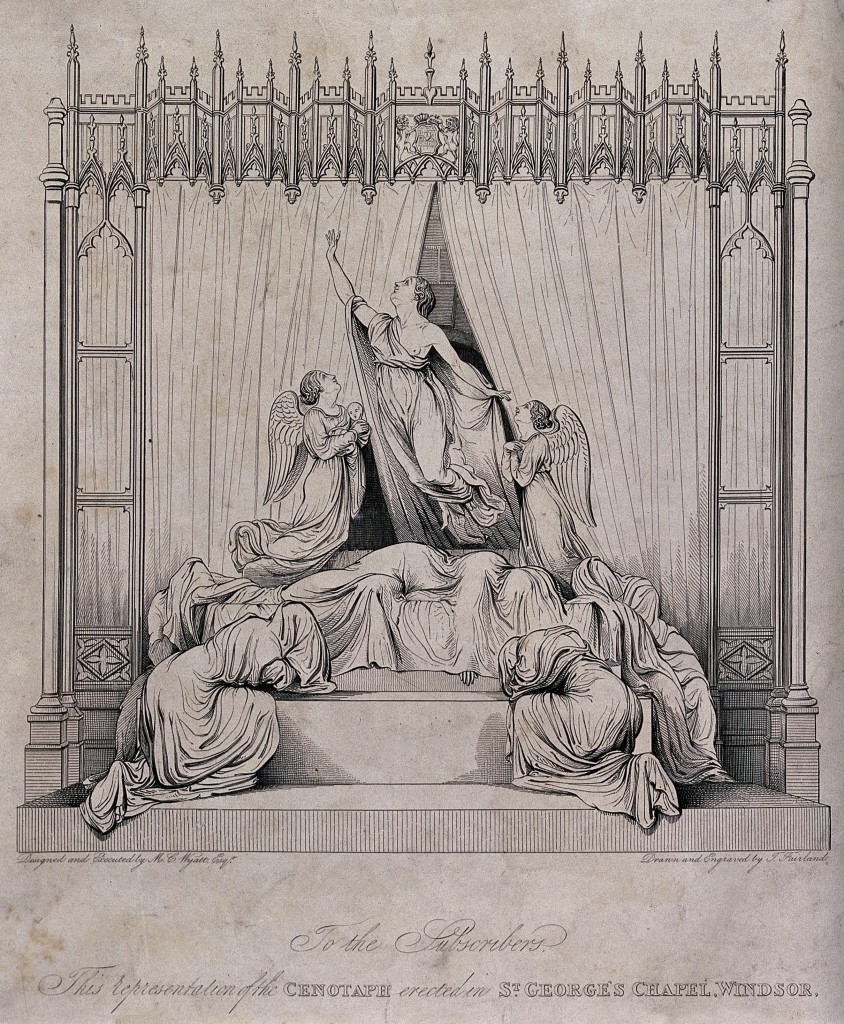
Cenotaph commemorating Princess Charlotte in St George's Chapel in Windsor. Lithograph after a sculpture by M.C. Wyatt, 1826 (© Wellcome Images)
There was another who felt that all the outpouring of grief over Charlotte was misdirected, and that was writer Percy Bysshe Shelley (1792-1822), who was married to Mary Shelley, author of Frankenstein. Shelley was so taken by what he had witnessed that he set to work on a piece dedicated to it: An Address to the People on The Death of Princess Charlotte, published shortly after the tragic events on 6 November. He was not hard-hearted about her demise; his introduction mourns the fact that a young woman, only too recently happy and well, was now suddenly lying dead in her tomb. However, Shelley very quickly brought up the heart of his discussion, that such a death in childbirth is all too common:
“How many women die in childbed and leave their families of motherless children and their husbands to live on, blighted by the remembrance of that heavy loss? … Men have watched by the bedside of their expiring wives, and have gone mad when the hideous death-rattle was heard within the throat…”
Shelley indeed saw the Princess’s death as a tragedy for her family, just like for any other family losing a wife, mother, daughter and sister. In other words, Charlotte’s passing was in no way remarkable—it was only remarkable because of who she was and the position she would have held had she lived. For the countless other women and their bereaved kin, Shelley caustically observes, “none weep for them—none mourn for them—none when their coffins are carried to the grave … turn aside and moralise upon the sadness they have left behind.” He does not chastise those who sincerely wept for their lost Princess, though, as it was the mark of good people. It was Shelley himself who wrote that she was “the last and best of her race.” But, again, reflecting on her death he unapologetically remarked that there were countless others like her, who were good and loving, yet cut down in the prime of their lives: “The accident of her birth neither made her life more virtuous nor her death more worthy of grief. For the public she had done nothing, either good or evil … She was born a Princess…” His Address is a plea for to others to recognise those souls who also deserved compassion and sympathy, though they do not glitter with gems and crowns. Though they shed tears for Charlotte, so his message want, their energies would be better cast on those who would benefit more from such endeavours, drawing particular attention to the legacy of Brandreth, Ludham and Turner.
On 6 November 1817, the very day of the princess’s death, Jeremiah Brandreth, William Ludham, and Isaac Turner met their ends upon the scaffold, as Shelley related, by “hanging and beheading,” after having been charged with treason for participation in the Pentrich Uprising in June of the same year. There is, according to Shelley, some question as to exact involvement of others, as he wrote that Brandreth claimed that he had been set up by William J. Oliver, a government spy: “OLIVER, brought him to this…but for OLIVER, he would not have been here [original italics].” Turner also proclaimed the involvement of Oliver, Shelley asserted; Shelley recorded that Turner was said to have shouted, whilst the noose was being readied about his neck, “THIS IS ALL OLIVER AND THE GOVERNMENT [original capitalization].” These men had family and friends whom loved them, and themselves held their own virtues. But here Shelley draws a distinctive line between the men and Princess Charlotte, suggesting their lower “station” allowed for them to be so expendable, so they were less worthy of public outcry and indignation. In a tone that chimes with potent relevancy with today’s question of capital punishment, Shelley saw that society needed a re-examination on such punishments, that “some restraint ought … to be imposed on those thoughtless men who imagine they can find in violence a remedy for violence.” Remember Charlotte, his piece concludes, but also remember those others also equally deserving of memorials.
The death of Princess Charlotte, a devastating knell for the royal family, touched the lives of many in Britain and abroad, and her fate in childbed was one shared by innumerable other women. And whilst it brought sadness, her death also brought about another English queen. That November of 1817 saw the elimination of any legitimate heirs beyond the Prince of Wales and his siblings. Whilst there had been five sisters in the family, by this time one had already died, one remained unmarried, and the other three who had married were all childless. Even if one had produced a legitimate child, however, it was highly unlikely they would have been contenders for the throne being superseded by the male line. Prince George, as the eldest son, was fifty-five in 1817, and his youngest brother forty-three. If they were going to produce legitimate heirs, now was the time to do it.
A veritable marriage race began in earnest. Prince Edward, Duke of Kent, with the hindsight of history, was the winner, but there was a tragic catch. He married the widowed Princess Victoire of Saxe-Coburg-Saalfeld, the elder sister of Prince Leopold. She already had two children by her late husband, Charles and Feodore; by royal estimates, this was solid evidence that Victoire could be expected to produce more offspring for her new husband, the Duke of Kent. In this, she did not disappoint. She and the Duke married in May 1818, and by that time the following year she had given birth to a healthy daughter. The Duke of Kent would not live to see his daughter grow up; he died in January 1820.
When it came time for the infant princess’s christening, one of the names presented to the Prince of Wales for his approval was Charlotte; however, this honour was rebuffed. Instead, the infant was christened Alexandrina Victoria, for the Russian emperor and the baby’s mother; in time, the child would be known by her second name, a name given to an age of empire. For such a fleeting moment, Britain may have indeed had a Queen Charlotte.
History is liberally littered with ‘what-ifs’, and it does make for interesting arguments. Given the length of Victoria’s reign, and her tumultuous journey to the throne and thereafter, it is tempting to debate how her cousin would have fared as sovereign, but there are a considerable number of variables that prevent its further exploration within the limits of this essay. Shelley called Princess Charlotte “the best and last of her race.” Was she truly? Or was it because she died before time allowed her to give way to Hanoverian leanings? November of 1817 obliterated any chance of knowing for sure.
Suggested Further Reading
- Aspinall, Arthur, Letters of the Princess Charlotte, 1811-1817 (Home and Van Thal, 1949).
- Chambers, James, Charlotte and Leopold: The True Story of the Original People’s Princess (Old Street Publishing, 2008).
- Hume, Jane, “The Funeral of Princess Charlotte,” Windsor Castle College of St George, Chapel Archives and Chapter Library, http://www.stgeorges-windsor.org/archives/blog/?tag=princess-charlotte
- Plowden, Alison, Caroline and Charlotte: Lives of Caroline of Brunswick and Princess Charlotte of Wales (Sidgwick & Jackson; Main Market Ed., 1989).
- Williams, Kate, Becoming Queen Victoria: The Tragic Death of Princess Charlotte and the Unexpected Rise of Britain’s Greatest Monarch (Ballantine Books, 2010).


